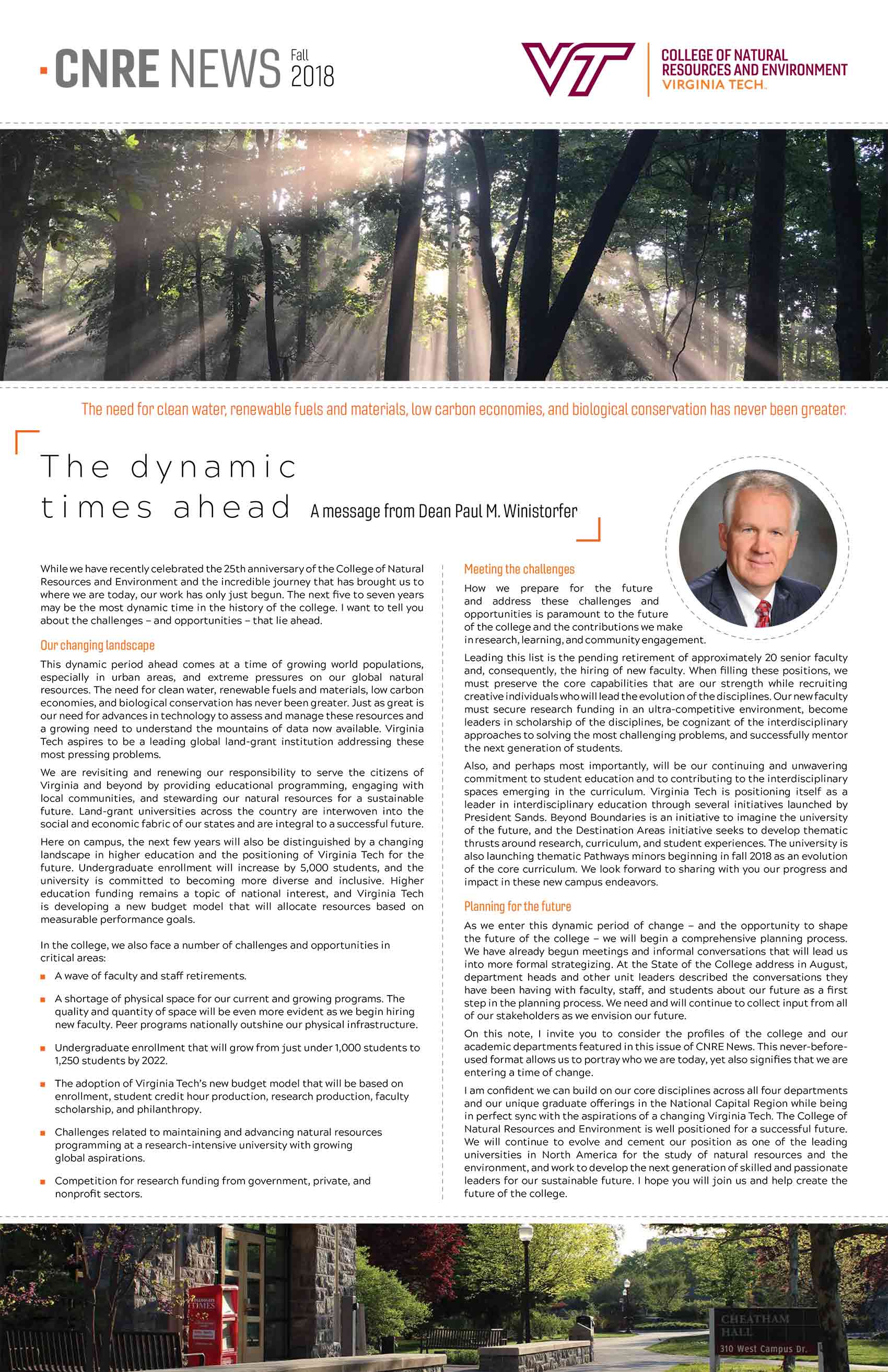The dynamic times ahead
A message from Dean Paul M. Winistorfer
November 9, 2018

A message from Dean Paul M. Winistorfer
Paul M. Winistorfer

While we have recently celebrated the 25th anniversary of the College of Natural Resources and Environment and the incredible journey that has brought us to where we are today, our work has only just begun. The next five to seven years may be the most dynamic time in the history of the college. I want to tell you about the challenges — and opportunities — that lie ahead.
Our changing landscape
This dynamic period ahead comes at a time of growing world populations, especially in urban areas, and extreme pressures on our global natural resources. The need for clean water, renewable fuels and materials, low carbon economies, and biological conservation has never been greater. Just as great is our need for advances in technology to assess and manage these resources and a growing need to understand the mountains of data now available. Virginia Tech aspires to be a leading global land-grant institution addressing these most pressing problems.
The need for clean water, renewable fuels and materials, low carbon economies, and biological conservation has never been greater.
We are revisiting and renewing our responsibility to serve the citizens of Virginia and beyond by providing educational programming, engaging with local communities, and stewarding our natural resources for a sustainable future. Land-grant universities across the country are interwoven into the social and economic fabric of our states and are integral to a successful future.
Here on campus, the next few years will also be distinguished by a changing landscape in higher education and the positioning of Virginia Tech for the future. Undergraduate enrollment will increase by 5,000 students, and the university is committed to becoming more diverse and inclusive. Higher education funding remains a topic of national interest, and Virginia Tech is developing a new budget model that will allocate resources based in part on measurable performance goals.
In the college, we also face a number of challenges and opportunities in critical areas:
- A wave of faculty and staff retirements.
- A shortage of physical space for our current and growing programs. The quality and quantity of space will be even more evident as we begin hiring new faculty. Peer programs nationally outshine our physical infrastructure.
- Undergraduate enrollment that will grow from just under 1,000 students to 1,250 students by 2022.
- The adoption of Virginia Tech’s new budget model that will be based on enrollment, student credit hour production, research production, faculty scholarship, and philanthropy.
- Challenges related to maintaining and advancing natural resources programming at a research-intensive university with growing global aspirations.
- Competition for research funding from government, private, and nonprofit sectors.
Meeting the challenges
How we prepare for the future and address these challenges and opportunities is paramount to the future of the college and the contributions we make in research, learning, and community engagement.
Leading this list is the pending retirement of approximately 20 senior faculty and, consequently, the hiring of new faculty. When filling these positions, we must preserve the core capabilities that are our strength while recruiting creative individuals who will lead the evolution of the disciplines. Our new faculty must secure research funding in an ultra-competitive environment, become leaders in scholarship of the disciplines, be cognizant of the interdisciplinary approaches to solving the most challenging problems, and successfully mentor the next generation of students.
Also, and perhaps most importantly, will be our continuing and unwavering commitment to student education and to contributing to the interdisciplinary spaces emerging in the curriculum. Virginia Tech is positioning itself as a leader in interdisciplinary education through several initiatives launched by President Sands. Beyond Boundaries is an initiative to imagine the university of the future, and the Destination Areas initiative seeks to develop thematic thrusts around research, curriculum, and student experiences. The university is also launching thematic Pathways minors beginning in fall 2018 as an evolution of the core curriculum. We look forward to sharing with you our progress and impact in these new campus endeavors.
Planning for the future
As we enter this dynamic period of change — and the opportunity to shape the future of the college — we will begin a comprehensive planning process. We have already begun meetings and informal conversations that will lead us into more formal strategizing. At the State of the College address in August, department heads and other unit leaders described the conversations they have been having with faculty, staff, and students about our future as a first step in the planning process. We need and will continue to collect input from all of our stakeholders as we envision our future.
On this note, I invite you to consider the profiles of the college and our academic departments featured in this issue of CNRE News. This never-before-used format allows us to portray who we are today, yet also signifies that we are entering a time of change.
I am confident we can build on our core disciplines across all four departments and our unique graduate offerings in the National Capital Region while being in perfect sync with the aspirations of a changing Virginia Tech. The College of Natural Resources and Environment is well positioned for a successful future. We will continue to evolve and cement our position as one of the leading universities in North America for the study of natural resources and the environment, and work to develop the next generation of skilled and passionate leaders for our sustainable future. I hope you will join us and help create the future of the college.




